Farmers’ Knowledge and Acceptance of Microalgae in Almería Greenhouse Horticulture
Abstract
1. Introduction
2. Materials and Methods
Sampling Strategy and Survey Design
3. Results
3.1. Farmers’ Knowledge Regarding Microalgae and Their Beneficial Use and Applications in Agriculture
3.2. Farmers’ Knowledge of Microalgae as Biostimulants and Biofertilizers in Agriculture
3.3. Farmer’s Knowledge Regarding Specific Microalgae’s Applications in Agriculture
3.4. Farmers’ Knowledge of Microalgae’s Capacity to Overcome Environmental Barriers of Almería Greenhouse Horticulture
4. Discussion
5. Conclusions
Author Contributions
Funding
Data Availability Statement
Acknowledgments
Conflicts of Interest
Appendix A. Online Survey
Appendix A.1. What Are Microalgae?
- 1.
- If I talk about microalgae, what comes to your mind? (Feel free to write whatever comes to your mind).
- 2.
- Do you know the word microalgae? Yes/No
- 3.
- Do you know the difference between seaweed and microalgae? Yes/No
- 4.
- Do you know if microalgae have beneficial uses for agriculture?
- (a).
- Yes, they have many benefits
- (b).
- Yes, they have some benefits
- (c).
- Yes, they have a few benefits
- (d).
- No, they have no benefits
- (e).
- I don’t know
- 5.
- If you answered yes to the previous question, list as many benefits as it comes to your mind (please separate each benefit with commas).
- 6.
- Do you know if microalgae are useful in agriculture?
- (a).
- Yes, they are very useful
- (b).
- Yes, they have some use
- (c).
- Yes, they have little use
- (d).
- No, they have no use
- (e).
- I don’t know
- 7.
- If you answered yes to the previous question, list as many utilities as you can think of (please separate each utility with commas).
Appendix A.2. Do You Know about Biostimulants?
- 8.
- Do you know or have used biostimulants or biofertilizers derived from microalgae in your crops?
- (a).
- Yes, I know both and I use both biostimulants and biofertilizers
- (b).
- Yes, I know both and I use biostimulants
- (c).
- Yes, I know both and I use biofertilizers
- (d).
- Yes, I know both but I don’t use either of them
- (e).
- No, I don’t know them
- 9.
- If you have used them as biostimulants, have they given you satisfactory results?
- (a).
- Yes, they have given me good results in tomato, cucumber, zucchini, eggplant, bell pepper, watermelon, melon, and others.
- (b).
- No, they have not given me satisfactory results.
- (c).
- I have not observed improvements in my crop
- (d).
- I am not compensated for their use in relation to their cost
- (e).
- Microalgae’application generates additional work
- (f).
- For other reasons
- 10.
- If they have given you satisfactory results in other crops, could you tell us which ones?
Appendix A.3. Possible Applications of the Use of Microalgae in Almería’s Agriculture
- 11.
- Of the benefits of microalgae shown in the panel, which ones do you think are important?
- 12.
- Of the above, choose the one most important for you and indicate why.
Appendix A.4. How Can Microalgae Help You Solve Your Problems?
- 13.
- We show some of the difficulties or problems encountered by farmers in Almería. For each of them, please indicate how these problems affect your crops. Remember that 0 means “It is not a problem” and 10 means “It is a big problem”.
- (a).
- Scarcity/quality of water resources.
- (b).
- Excessive use of chemical fertilizers.
- (c).
- Effectiveness of chemical pesticide use.
- (d).
- Effectiveness of using biological control.
- (e).
- Need to improve the quality of my crop.
- (f).
- The low resistance of my crop.
- (g).
- Low utilization of the nutrients I provide to my crops.
- (h).
- Indicate if there is any other problem or difficulty that has not been mentioned.
- 14.
- Do you think that microalgae can help to overcome any of these barriers? Yes/No/I don’t know.
- 15.
- If yes, what environmental barrier for agriculture do you think microalgae can help with (you may select more than one option)?
- (a).
- Scarcity/quality of water resources.
- (b).
- Excessive use of chemical fertilizers.
- (c).
- Effectiveness of chemical pesticide use.
- (d).
- Effectiveness of using biological control.
- (e).
- Need to improve the quality of my crop.
- (f).
- Low resistance of my crop.
- (g).
- Low utilization of the nutrients I provide to my crops.
- 16.
- Are you in favour of promoting the use of biostimulants derived from microalgae? Yes/No/I don’t know.
- 17.
- If biostimulants derived from microalgae whose benefits have been demonstrated were commercialized, would you be willing to sponsor them?
Appendix A.5. To Get to Know You Better
- 18.
- Where do you live? Please indicate your zip code:
- 19.
- Do you come from a farming family? Yes/No.
- 20.
- Do you own land or have a lease?
- (a).
- Yes, I am a landowner
- (b).
- Yes, I have a land lease
- (c).
- No.
- 21.
- How many people work in your business?
- 22.
- Could you tell me what you usually grow?
- (a).
- Tomato
- (b).
- Cucumber
- (c).
- Zucchini
- (d).
- Eggplant
- (e).
- Pepper
- (f).
- Watermelon
- (g).
- Melon, Others.
- 23.
- On how much land do you grow these crops?
- 24.
- Do you have organic crops? Yes/No.
- 25.
- What is your highest level of education completed?
- (a).
- None
- (b).
- Primary education
- (c).
- Secondary education
- (d).
- High school
- (e).
- University
- (f).
- Others
- (g).
- I prefer not to say.
- 26.
- Could you tell us your age?
- (a).
- Under 20 years old
- (b).
- Between 20 and 30 years old
- (c).
- Between 30 and 45 years old
- (d).
- Between 45 and 65 years old
- (e).
- Over 65 years old.
- 27.
- Gender: male/female.
- 28.
- Did you find the survey comprehensible?
- (a).
- Not at all comprehensible
- (b).
- Not very comprehensible
- (c).
- Quite comprehensible
- (d).
- Very comprehensible
Appendix B. Panel
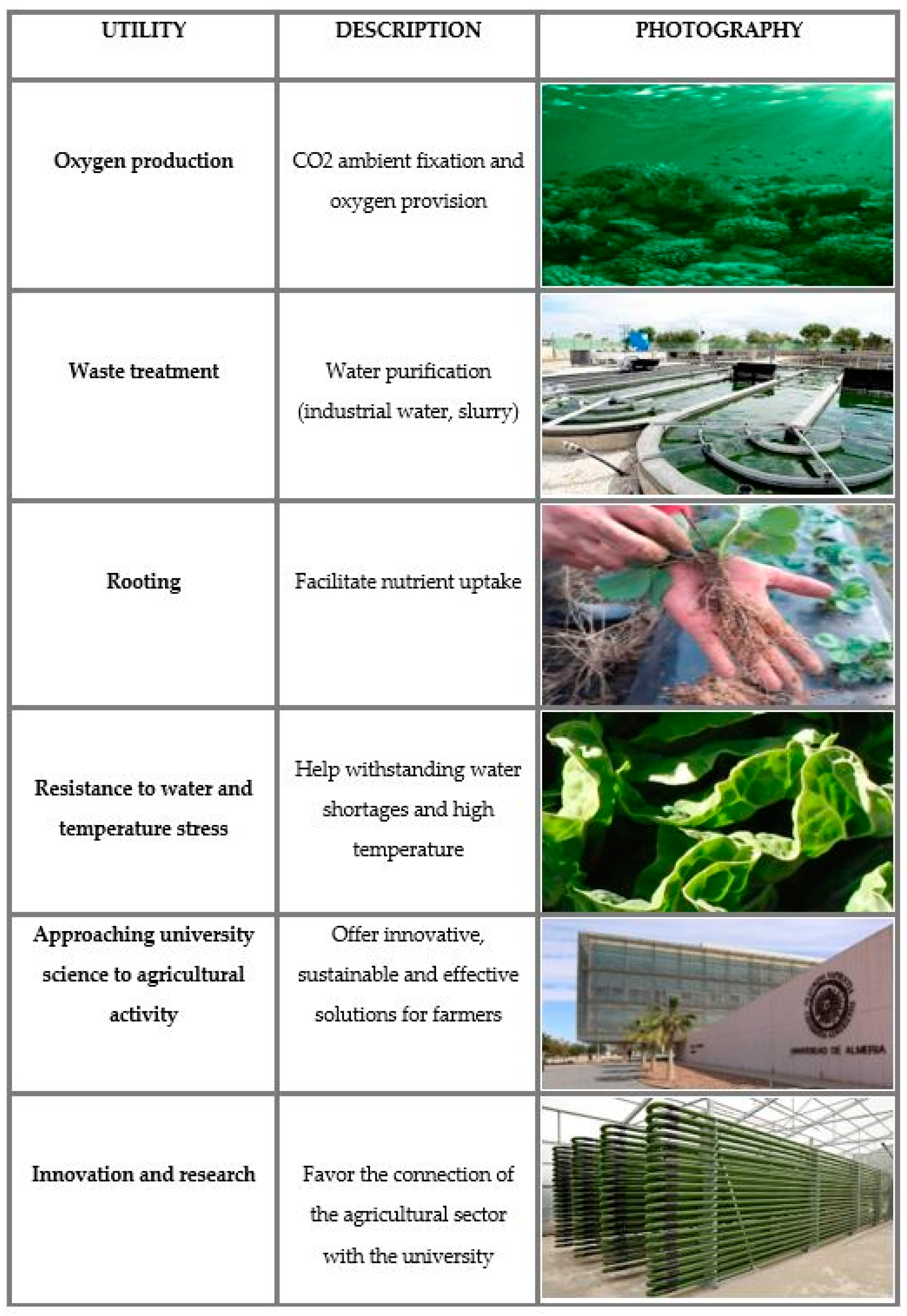
References
- Castro, A.J.; López-Rodríguez, M.D.; Giagnocavo, C.; Gimenez, M.; Céspedes, L.; La Calle, A.; Gallardo, M.; Pumares, P.; Cabello, J.; Rodríguez, E.; et al. Six Collective Challenges for Sustainability of Almería Greenhouse Horticulture. Int. J. Environ. Res. Public Health 2019, 16, 4097. [Google Scholar] [CrossRef] [PubMed]
- Marc, B.; Berndt, C. B/ordering the mediterranean: Free trade, fresh fruits and fluid fixity. In Seasonal Workers in Mediterranean Agriculture. The Social Cost of Eating Fresh; Gertel, J., Sippel, S.R., Eds.; Routledge: London, UK, 2014; pp. 23–35. [Google Scholar]
- Mota, J.F.; Castro, H.; Cabello, J.; Guirado, J.S. Agricultural development vs biodiversity conservation: The Mediterranean semiarid vegetation in El Ejido (Almería, southeastern Spain). Biodivers. Conserv. 1996, 5, 1597–1617. [Google Scholar] [CrossRef]
- Quintas-Soriano, C.; Castro, A.J.; García-Llorente, M.; Cabello, J.; Castro, H. From supply to social demand: A landscape-scale analysis of the water regulation service. Landsc. Ecol. 2014, 29, 1069–1082. [Google Scholar] [CrossRef]
- Giagnocavo, C.; Galdeano-Gómez, E.; Pérez-Mesa, J.C. Cooperative Longevity and Sustainable Development in a Family Farming System. Sustainability 2018, 10, 2198. [Google Scholar] [CrossRef]
- Lafarga, T.; Pieroni, C.; D’Imporzano, G.; Maggioni, L.; Adani, F.; Acién, G. Consumer Attitudes towards Microalgae Production and Microalgae-Based Agricultural Products: The Cases of Almería (Spain) and Livorno (Italy). ChemEngineering 2021, 5, 27. [Google Scholar] [CrossRef]
- Arioli, T.; Mattner, S.W.; Winberg, P.C. Applications of seaweed extracts in Australian agriculture: Past, present and future. J. Appl. Phycol. 2015, 27, 2007–2015. [Google Scholar] [CrossRef] [PubMed]
- Calvo, P.; Nelson, L.; Kloepper, J.W. Agricultural uses of plant biostimulants. Plant Soil 2014, 383, 3–41. [Google Scholar] [CrossRef]
- Gonzalo, M.; Proaño, C.; María Fernández, J.; Cotutor, S.; Serrano, G.; Proaño, M.C. Optimización de la hidrólisis enzimática de Scenedesmus almeriensis para la aplicación como biofertilizante. Master’s Thesis, Universidad de Almería, Almería, Spain, 2017. [Google Scholar]
- Witek-Krowiak, A.; Chojnacka, K.; Podstawczyk, D.; Dawiec, A.; Pokomeda, K. Application of response surface methodology and artificial neural network methods in modelling and optimization of biosorption process. Bioresour. Technol. 2014, 160, 150–160. [Google Scholar] [CrossRef] [PubMed]
- Khan, S.; Khan, M.; Hanjra, M.; Mu, J. Pathways to reduce the environmental footprints of water and energy inputs in food production. Food Policy 2008, 34, 141–149. [Google Scholar] [CrossRef]
- Du Jardin, P. Plant biostimulants: Definition, concept, main categories and regulation. Sci. Hortic. 2015, 196, 3–14. [Google Scholar] [CrossRef]
- Povero, G.; Mejia, J.F.; Di Tommaso, D.; Piaggesi, A.; Warrior, P. A Systematic Approach to Discover and Characterize Natural Plant Biostimulants. Front. Plant Sci. 2016, 7, 1–9. [Google Scholar] [CrossRef] [PubMed]
- Michalak, I.; Chojnacka, K.; Dmytryk, A.; Wilk, R.; Gramza, M.; Rój, E. Evaluation of Supercritical Extracts of Algae as Biostimulants of Plant Growth in Field Trials. Front. Plant Sci. 2016, 7, 1591. [Google Scholar] [CrossRef] [PubMed]
- Borowitzka, M.A. High-value products from microalgae—Their development and commercialisation. J. Appl. Phycol. 2013, 25, 743–756. [Google Scholar] [CrossRef]
- Streit, N.; Jacob-Lopes, E.; Zepka, L.Q.; Mérida, L.G.R.; Queiroz, M. Producción de pigmentos naturales (clorofila-a) en biorrefinerias agroindustriales. Cienc. Tecnol. 2015, 8, 27–34. [Google Scholar] [CrossRef]
- Quintas-soriano, C.; Castro, A.J.; Castro, H.; García-llorente, M. Impacts of land use change on ecosystem services and implications for human well-being in Spanish drylands. Land Use Policy 2016, 54, 534–548. [Google Scholar] [CrossRef]
- Morillas-España, A.; Lafarga, T.; Gómez-Serrano, C.; Acién-Fernández, F.G.; González-López, C.V. Year-long production of Scenedesmus almeriensis in pilot-scale raceway and thin-layer cascade photobioreactors. Algal Res. 2020, 51, 102069. [Google Scholar] [CrossRef]
- Garrido-Cardenas, J.A.; Manzano-Agugliaro, F.; Acien-Fernandez, F.G.; Molina-Grima, E. Microalgae research worldwide. Algal Res. 2018, 35, 50–60. [Google Scholar] [CrossRef]
- Lafarga, T.; Rodríguez-Bermúdez, R.; Morillas-España, A.; Villaró, S.; García-Vaquero, M.; Morán, L.; Sánchez-Zurano, A.; González-López, C.V.; Acién-Fernández, F.G. Consumer knowledge and attitudes towards microalgae as food: The case of Spain. Algal Res. 2021, 54, 102174. [Google Scholar] [CrossRef]
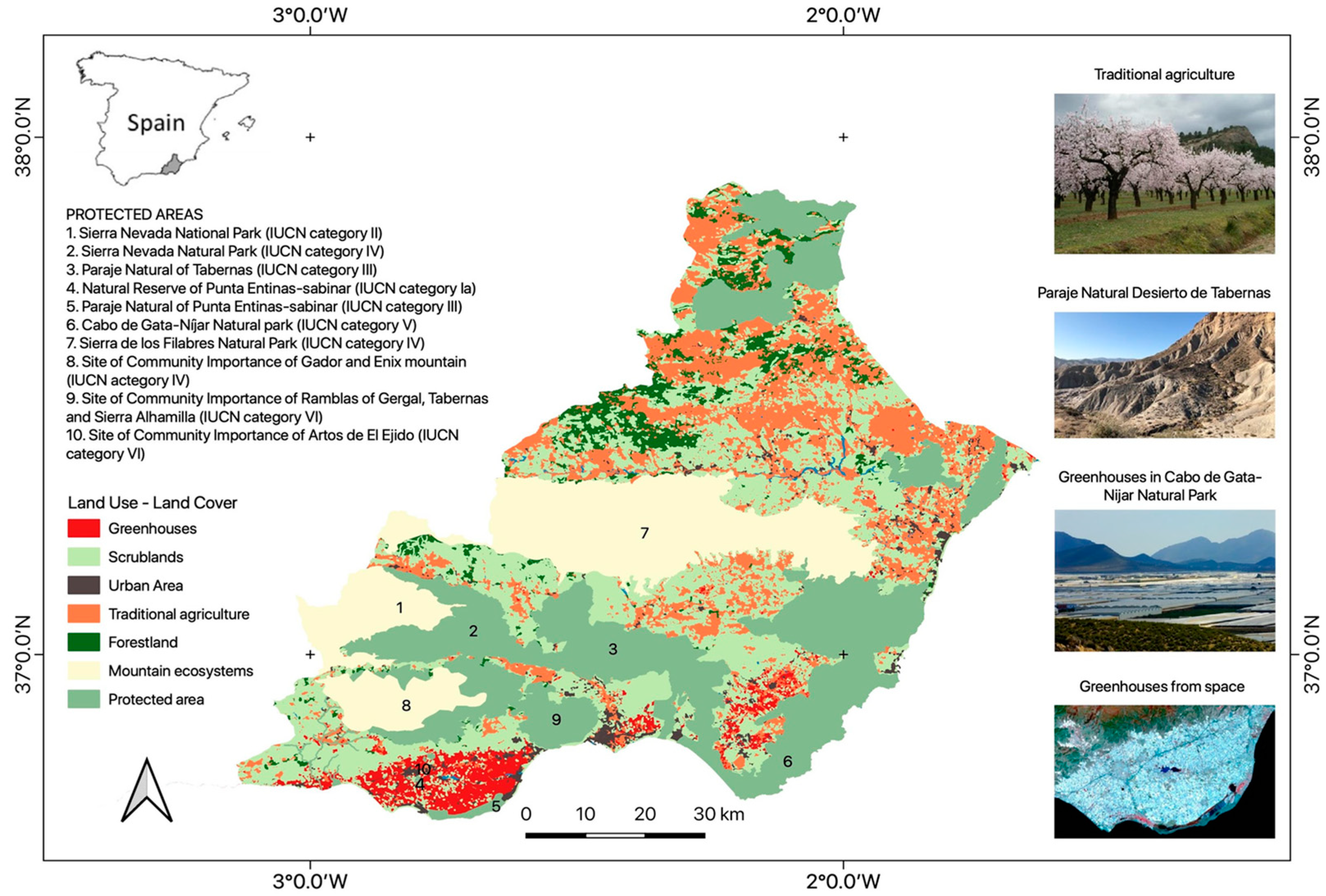
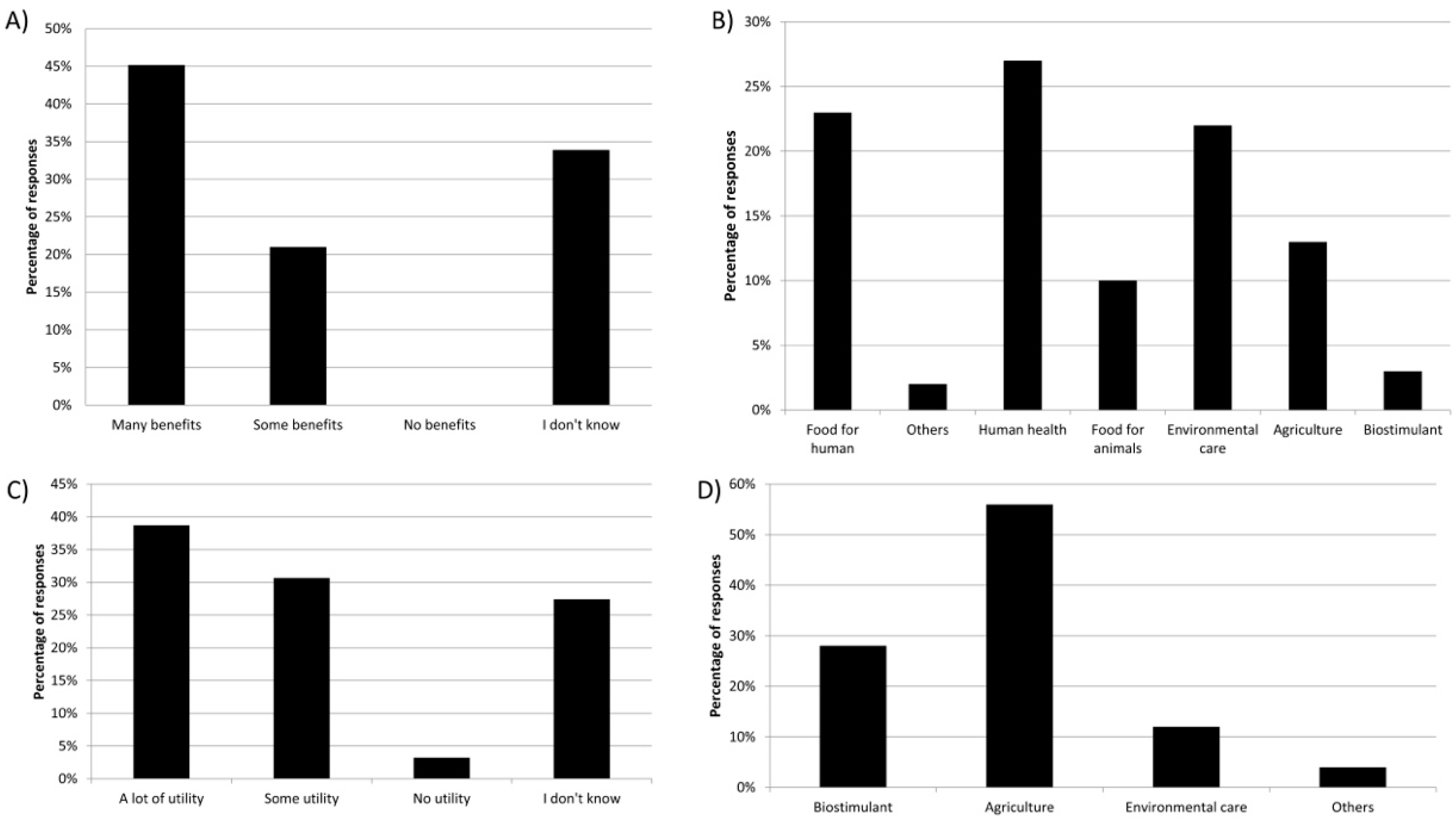
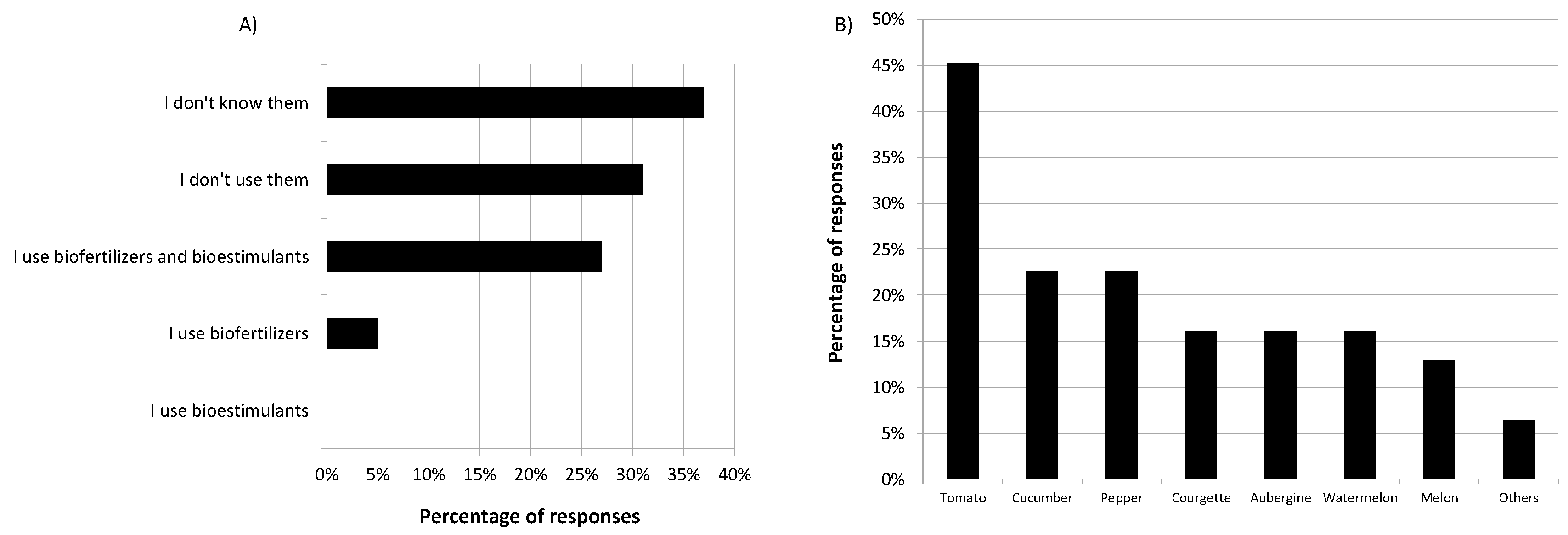
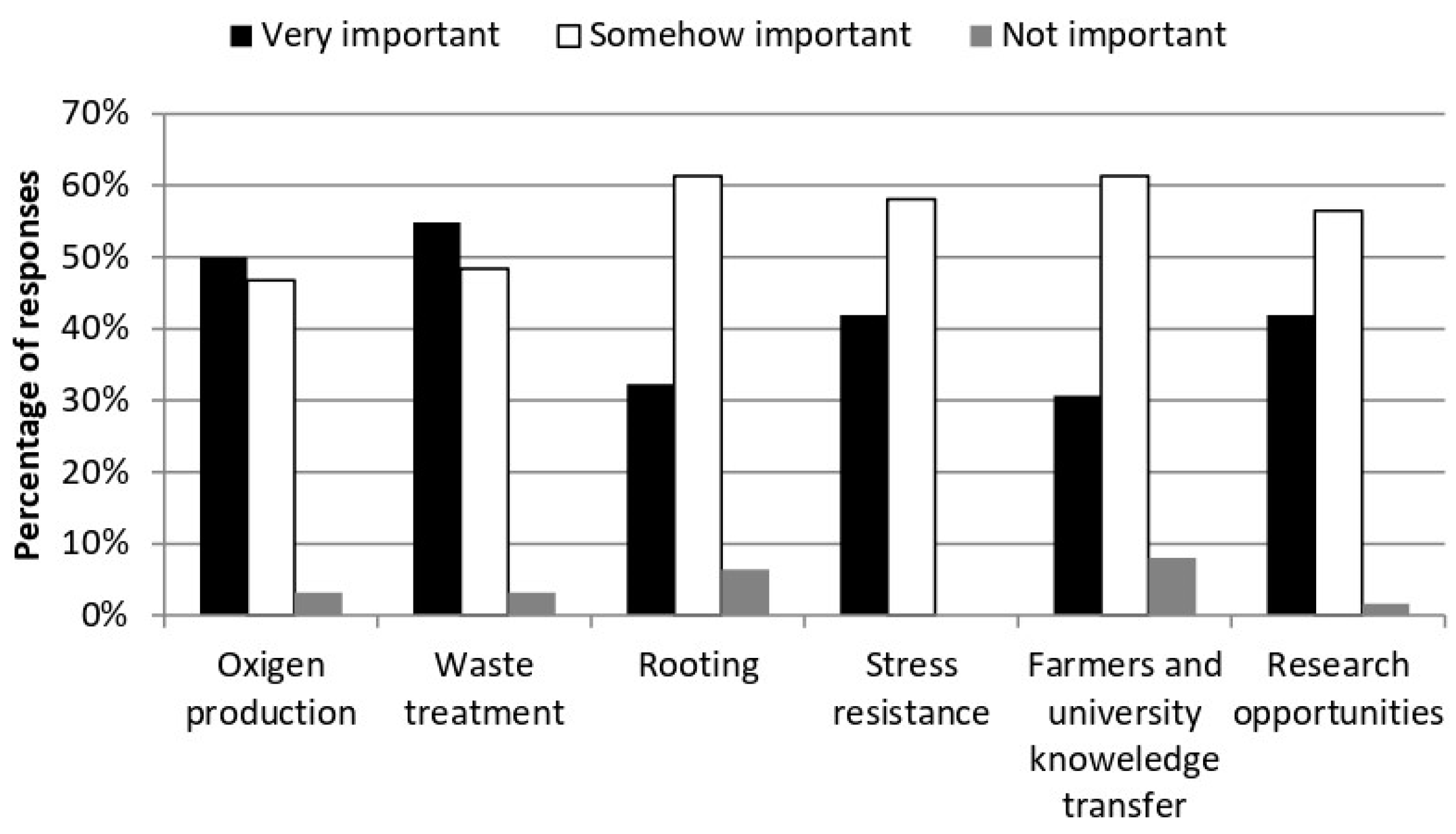
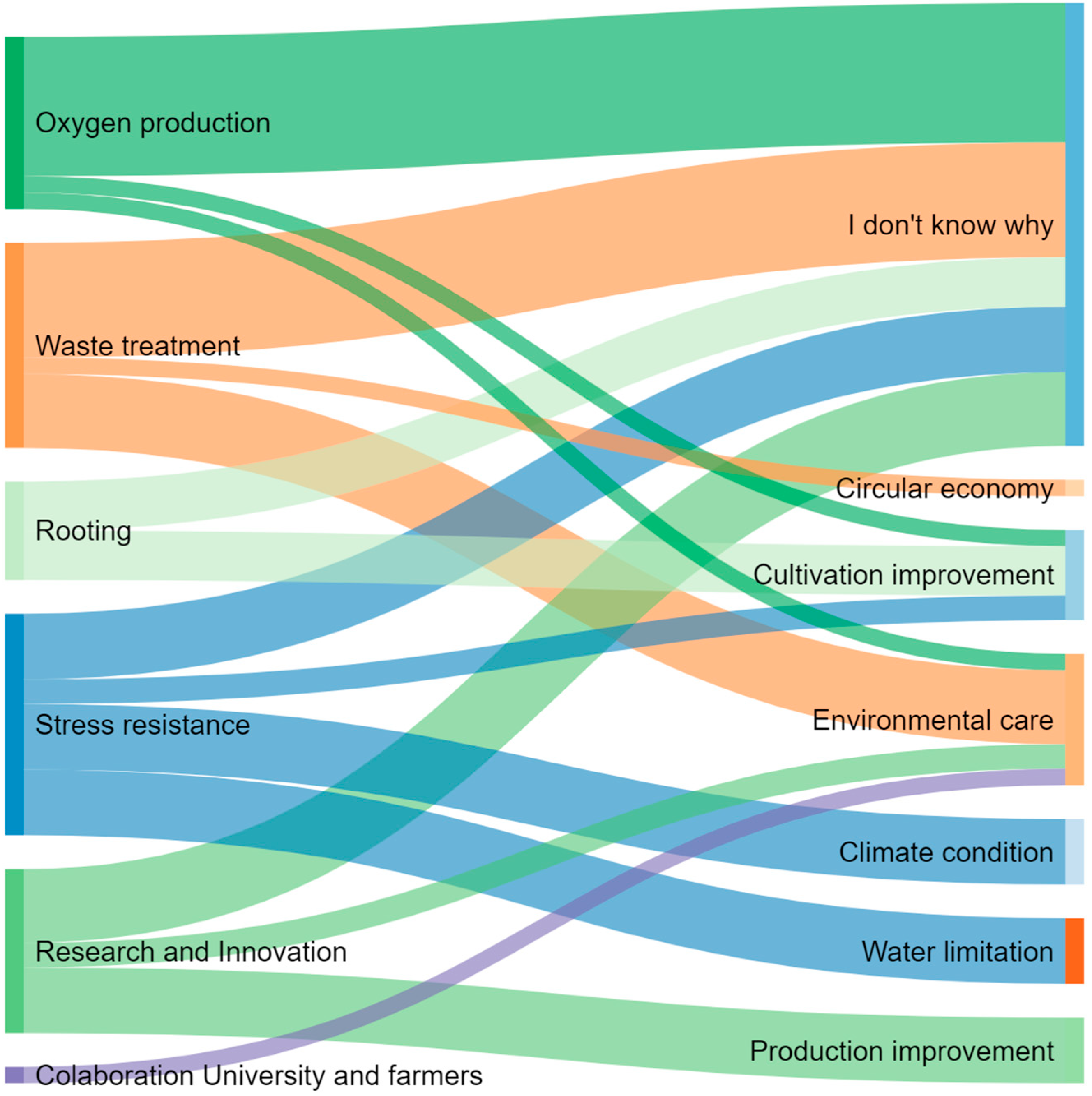
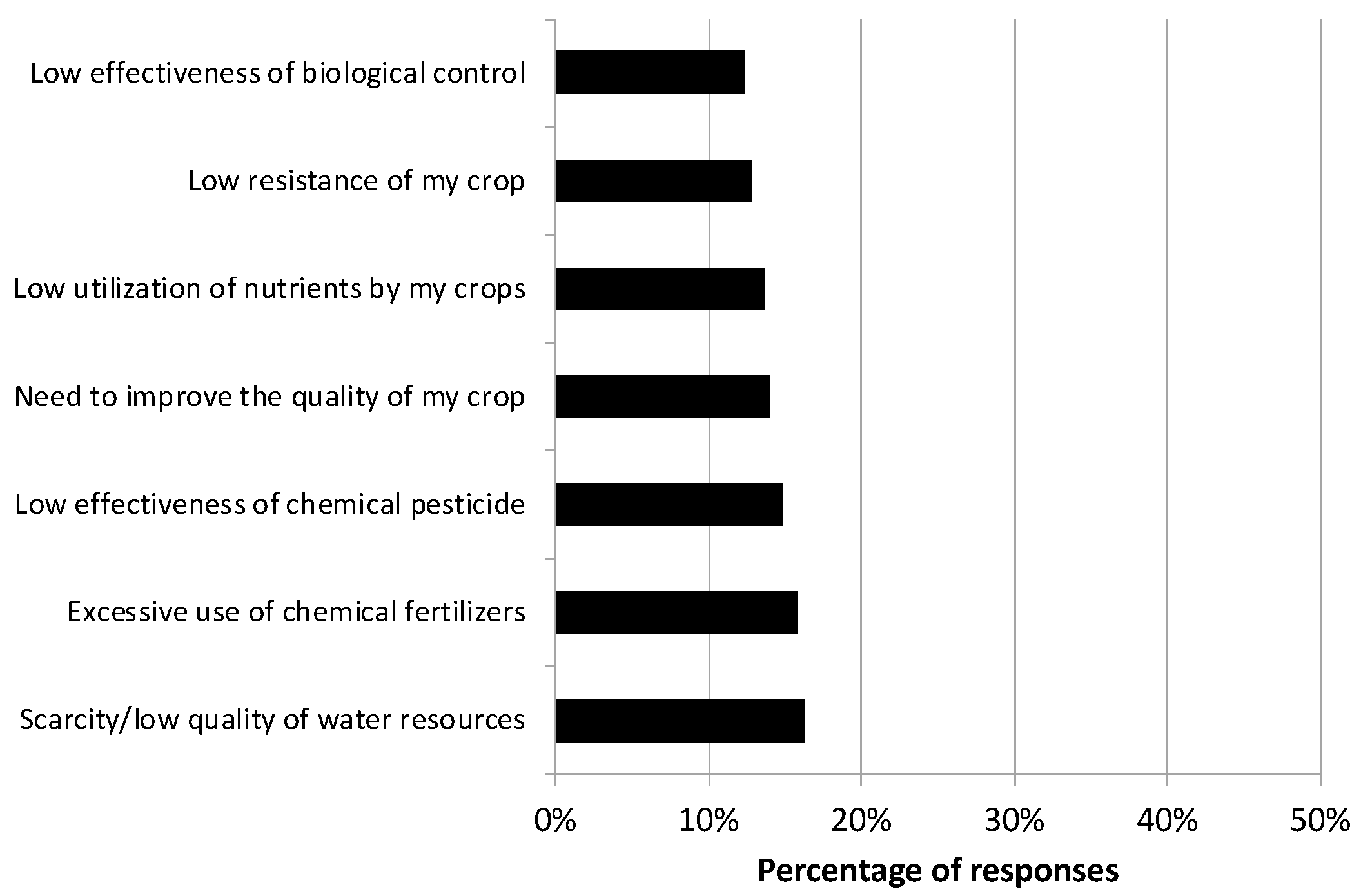
| Sociodemographic Variables | ||
| Yes | No | |
| Family of farmers | 65% | 34% |
| Land ownership | 40% | 60% |
| Organic farming | 26% | 74% |
| University studies | 50% | 50% |
| Less than 30 | More than 30 | |
| Age | 35% | 65% |
| Less than 10 | More than 10 | |
| Number of workers | 84% | 16% |
| Male | Female | |
| Gender | 50% | 50% |
Publisher’s Note: MDPI stays neutral with regard to jurisdictional claims in published maps and institutional affiliations. |
© 2022 by the authors. Licensee MDPI, Basel, Switzerland. This article is an open access article distributed under the terms and conditions of the Creative Commons Attribution (CC BY) license (https://creativecommons.org/licenses/by/4.0/).
Share and Cite
Ruiz-Nieto, Á.; Gómez-Serrano, C.; Acién, G.; Castro, A.J. Farmers’ Knowledge and Acceptance of Microalgae in Almería Greenhouse Horticulture. Agronomy 2022, 12, 2778. https://doi.org/10.3390/agronomy12112778
Ruiz-Nieto Á, Gómez-Serrano C, Acién G, Castro AJ. Farmers’ Knowledge and Acceptance of Microalgae in Almería Greenhouse Horticulture. Agronomy. 2022; 12(11):2778. https://doi.org/10.3390/agronomy12112778
Chicago/Turabian StyleRuiz-Nieto, Ángela, Cintia Gómez-Serrano, Gabriel Acién, and Antonio J. Castro. 2022. "Farmers’ Knowledge and Acceptance of Microalgae in Almería Greenhouse Horticulture" Agronomy 12, no. 11: 2778. https://doi.org/10.3390/agronomy12112778
APA StyleRuiz-Nieto, Á., Gómez-Serrano, C., Acién, G., & Castro, A. J. (2022). Farmers’ Knowledge and Acceptance of Microalgae in Almería Greenhouse Horticulture. Agronomy, 12(11), 2778. https://doi.org/10.3390/agronomy12112778








